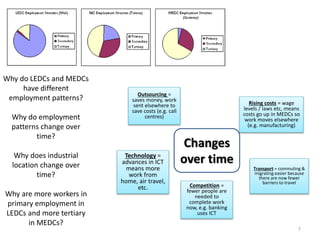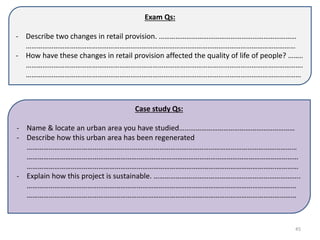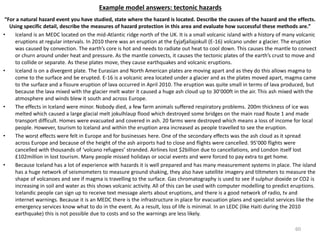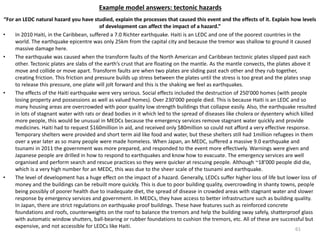This document provides revision materials for a GCSE Geography exam on key themes. It includes information on the exam structure, resources for revision, and details on the three exam sections: natural hazards, population and settlement, and economic development. For the economic development section, it outlines different industry types and changes over time, as well as case studies on topics like goat aid and Coca-Cola. Various practice exam questions are provided at the end related to development indicators, the Brandt line, and Rostow's model of development stages.

















![Exam Qs
• Describe & explain how a low literacy rate can link to low $GDP per
capita. [3marks]
• Explain what is meant by the North-South Divide. [3marks]
• Suggest and explain one reason for development to be slower in
some countries. [3marks]
• How valid is the North-South Divide (Brandt Line) today? Is it still
accurate? [2marks]
• What conditions would be required for a nation to reach ‘take off’
in the Rostow Model and begin becoming an NIC? [3marks]
• What is meant by ‘high mass consumption’? [1mark]](https://image.slidesharecdn.com/keythemesrevisionpack2016-151112210401-lva1-app6891/85/Key-themes-revision-pack-2016-18-320.jpg)































![Overpopulation
• Whether an area is overpopulated depends on a range of factors and NOT just on
the size of the population
• Overpopulation may also be for a CITY, a REGION or a whole COUNTRY
TOP 5 overpopulated countries:
1. China
2. Singapore
3. India
4. USA
5. Indonesia
Overpopulation = when there are too many organisms (i.e. humans) within an area for
the amount of resources available. It does not mean just a large population.
Carrying capacity = the number of organisms (humans) that an area can cope with
given its resources of land, food, water, space, jobs, etc.
Optimum population = the ideal number of people that a location can comfortably and
efficiently support
With reference to a named example, describe
some of the potential impacts of
overpopulation. [4marks]
What might influence the carrying capacity of
an area? [2marks] 50](https://image.slidesharecdn.com/keythemesrevisionpack2016-151112210401-lva1-app6891/85/Key-themes-revision-pack-2016-50-320.jpg)















